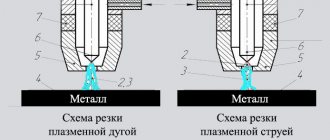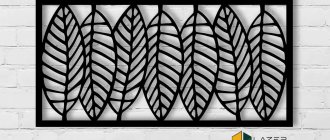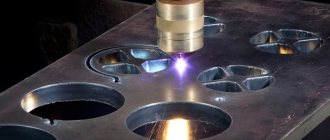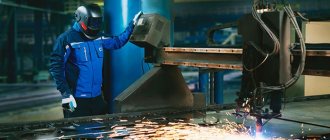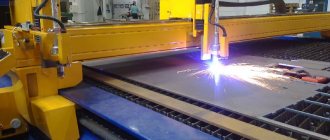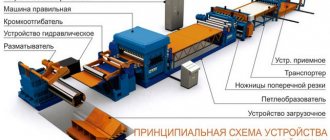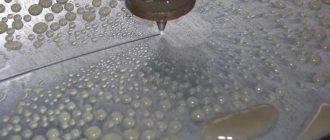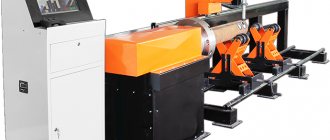The introduction of plasma processing into industry marked a technological breakthrough and a transition to a qualitatively new level of production. The scope of application of the beneficial properties of plasma is very wide. First of all, this is the production of electronics and semiconductor devices. Without plasma-chemical etching, the light would hardly be seen by modern high-performance personal computers. But that's not all.
Ion plasma processing is also used in optics and mechanical engineering for polishing products, applying protective coatings, diffusion saturation of the surface of metals and alloys, as well as for welding and cutting sheet steel. In this work, the main focus is on welding and cutting technologies using plasma.
General provisions
From school physics lessons, everyone knows that matter can exist in four states: solid, liquid, gas, and plasma. The most questions arise when trying to imagine the last state. But in reality, everything is not so difficult. Plasma is also a gas, only its molecules are, as they say, ionized (that is, separated from electrons). This state can be achieved in different ways: as a result of exposure to high temperatures, and also as a result of electron bombardment of gas atoms in a vacuum.
Such plasma is usually called low-temperature. This process physics is used when carrying out plasma spraying (etching, saturation) in a vacuum. By placing plasma particles in a magnetic field, they can be given directional movement. As practice has shown, such processing is more effective in a number of parameters of classical operations in mechanical engineering technology (saturation in powder media, flame cutting, pouring with chromium oxide-based paste, and so on).
Types of plasma treatment
Currently, plasma is actively used in almost all sectors of industry and the national economy: medicine, mechanical engineering, instrument making, construction, science, and so on.
Instrumentation was a pioneer in the use of plasma technologies. Industrial applications of plasma processing began by using the properties of ionized gas to atomize all kinds of materials and deposit them on pads, as well as to etch channels to produce microcircuits. Depending on some features of the design of technological installations, plasma-chemical etching, ion-chemical, and ion-beam etching are distinguished.
The development of plasma is an incredibly valuable contribution to the development of technology and, without exaggeration, improving the quality of life of all humanity. Over time, the scope of application of gas ions has expanded. And today, plasma processing (in one form or another) is used to create materials with special properties (heat resistance, surface hardness, corrosion resistance, etc.), for effective metal cutting, for welding, for polishing surfaces and eliminating micro-irregularities.
This list does not limit the use of technologies based on the effect of plasma on the surface being treated. Currently, means and methods of plasma spraying are being actively developed using various materials and processing modes in order to achieve maximum mechanical and physical properties.
Principle of operation
For plasma cutting of metal, a plasma jet is applied to the workpiece. Plasma is a stream of ionized gas heated to a temperature of thousands of degrees, which is electrically conductive and moves at high speed. The formation of a plasma arc from an electric one is carried out using a plasma cutter. The operating principle of the plasma cutter and the stages of the cutting process:
- A pilot electric arc is formed, which is ignited between the electrode of the plasma cutter and its nozzle or the metal being processed.
- After the pilot arc is formed, compressed gas is supplied to the chamber. It expands in volume and heats up to a temperature of 20,000 °C.
- The electric arc ionizes the gas, it becomes a conductor of electricity and turns into a plasma jet. This jet heats the metal in the processing zone, melts it and produces cutting.
Different principles of gas plasma cutting are used for metals and non-metallic materials. There are two ways to process materials:
- The arc burns between the plasma torch and the product. This is how a direct action cutter works. The product must be conductive. If it is necessary to cut non-metallic products, the indirect method is used.
- The arc is ignited in the plasmatron itself between the electrode and the nozzle. The electrode is the cathode, and a positive potential is applied to the nozzle.
The essence of plasma welding
Unlike installations of ion-plasma saturation and sputtering, in this case plasma treatment is carried out using high-temperature plasma. The efficiency of this method is higher than when using traditional welding methods (gas flame, electric arc, submerged arc welding, and so on). As a rule, ordinary atmospheric air under pressure is used as the working gas mixture. Thus, this technique is characterized by the absence of costs for consumable gases.
Plasma technology
Plasma technology is based on the processing of raw materials with concentrated energy flows. Plasma chemistry studies processes occurring at temperatures of 8000–10,000 °C, when the substance is in the form of plasma. Plasma is a partially or fully ionized gas that has almost the same density of positive or negative charges. Plasma can be low-temperature (about + 105 °C) and high-temperature (+106..108 °C).
Installations that allow continuous, controlled heating of gas to high temperatures are called low-temperature plasma generators (arc or high-frequency plasma torches).
The main areas of application of plasma technologies are chemistry, metallurgy, and mechanical engineering.
During plasma processing, the shape, dimensions, structure of the material being processed or the condition of its surface change. Plasma processing includes: separation and surface cutting, coating, surfacing, welding, rock destruction (plasma drilling).
Low-temperature plasma has become more widely used in industrial processes. Plasmatrons and devices for spraying powder metals and their compounds have been created, the use of which gives a significant effect.
Non-electrically conductive materials (concrete, granite, thin-sheet organic materials) are treated with a plasma jet (the arc burns in the nozzle of a plasma torch between its electrodes). Coatings are applied (spraying) to protect parts operating at high temperatures, in aggressive environments or subject to intense mechanical stress.
The coating material (refractory metals, oxides, carbides, silicides, borides, etc.) is introduced in the form of powder or wire into a plasma jet, in which it melts, sprays, acquires a speed of -100-200 m/s and in the form of small particles (20 -100 microns) is applied to the surface of the product. Plasma coatings have low thermal conductivity and are highly resistant to thermal shock. The power of spraying installations is 5-30 kW, maximum productivity is 5-10 kg of sprayed material per hour.
To obtain powders with spherical particle shapes used in powder metallurgy, a material is introduced into the plasma jet, the particles of which, when melted, acquire a spherical shape under the action of surface tension forces. The particle size can be adjusted from a few microns to 1 mm. Smaller (ultradisperse) powders with particle sizes of 10 nm and above are obtained by evaporation of the starting material in plasma and its subsequent condensation.
A technology has been developed for plasma spraying of wear-resistant powder on the surface of blades made of inexpensive steel. Screws obtained in this way are relatively cheap and last several times longer than those made of alloy steel.
Metal cutting is carried out by a compressed plasma arc , which burns between the anode (metal being cut) and the cathode of the plasma torch. Stabilization and compression of the arc channel, increasing its temperature, are carried out by the torch nozzle and blowing the arc with a flow of plasma-forming gas (Ar, N2, H2, NH4 and their mixtures).
To intensify the cutting of metals, chemically active plasma is used. For example, when cutting with air plasma, oxygen, oxidizing the metal, provides an additional energy contribution to the cutting process. Plasma arcs are used to cut stainless and chromium-nickel steels, Cu, Al and other metals and alloys that are not amenable to oxygen cutting. The high productivity of plasma cutting allows its use in continuous production processes. The power of the installations reaches 150 kW.
The property of a plasma arc to penetrate deeply into metal is used for welding metals. It is possible to weld metal 10-15 mm thick without special cutting of edges. Plasma arc welding is characterized by high productivity and, due to the high stability of the arc, good quality. A low-power plasma arc at currents of 0.1–40 A is convenient for welding thin sheets (0.05 mm) in the manufacture of membranes, bellows, and heat exchangers from Ta, Ti, Mo, W, Al.
Industrial organizations use plasma-mechanical processing of metals, the essence of which is to soften the surface of workpieces before cutting. This makes it possible to increase the processing speed and increase the thickness of the removed chips. It has been established that the introduction of the plasma-mechanical method of processing manganese steels helps to increase labor productivity by 4–10 times, and titanium alloys by 15 times.
Plasma technology is associated with the advent of metal concrete, where steel, cast iron, aluminum, lead, etc. are used as a binder. Previously, this was impossible to do due to weak contact adhesion between the metal and the mineral filler.
Plasma technology allows for rapid surface melting of rock particles, which ensures good collaboration between the metal and the mineral filler. The resulting metal concrete is 10 times stronger than ordinary concrete in compression and 100 times stronger in tension.
When plasma treats the surface of brick, concrete walls or walls whose surface is lined with ceramic tiles, a glassy melt is formed, which reliably protects the building from moisture and atmospheric influences. If solutions of salts of various metals are first applied to the walls of a building, their surfaces will acquire the appropriate color. Using plasmatrons, it is possible to recycle organochlorine waste that was previously thrown away. From them it is possible to obtain new substances needed for various industries. This is the path to waste-free, environmentally friendly technologies.
In the technological processes of creating ultra-large and ultra-high-speed ion sources, ion, ion-plasma and plasma-chemical processes of interaction of ion flows and low-temperature plasma with the surface of a solid are widely used. In universal technological systems equipped with ion sources, many cleaning, ion-beam etching and sputtering operations can be performed.
Ion implantation and reactive ion beam etching (RIBE) technologies are widely used in semiconductor microelectronics.
The use of a set of electron-ion processes - elion technology - makes it possible to increase the accuracy of manufacturing microstructures and create high-performance automated industrial equipment.
Advantages of plasma welding
Compared to traditional types of welding, using a plasma welding machine is safer. The reason is quite clear - the use of atmospheric oxygen under pressure as a working gas. Currently, occupational safety receives very close attention from business owners, managers and supervisory authorities.
Another very important advantage is the high quality of the weld (minimum sagging, lack of fusion and other defects). Although, in order to learn how to skillfully use a plasma welding machine, many months of practice are required. Only in this case will the weld and joints as a whole meet high standards.
This technology has a number of other advantages. Among them: high speed of the welding process (productivity increases), low energy consumption (electricity), high joint accuracy, absence of deformation and warping.
What is the process of plasma metal cutting?
Plasma is a conductive ionized gas of high temperature. A jet is formed in a special device - a plasmatron. It consists of the following main elements:
- Electrode (cathode) – is equipped with an insert made of a material with high thermionic emission (hafnium, zirconium), which burns out during operation and requires replacement when more than 2 mm is produced.
- Gas flow swirl mechanism.
- The nozzle is usually isolated from the cathode by a special bushing.
- Shroud – Protects internal components from molten metal splashes and metal dust.
The air plasma cutting power source has 2 wires - the anode (with a positive charge) and the cathode (with a negative charge). The “positive” wire is connected to the rolled metal being cut, the “negative” wire is connected to the electrode.
At the beginning of the process of plasma cutting of metal, a pilot arc is ignited between the cathode and the tip, which is blown out of the nozzle, and when it touches the workpiece, it forms a cutting arc.
When the forming channel in the plasma torch is filled with an arc column, a plasma-forming gas begins to be supplied into the arc chamber under a pressure of several atmospheres, which is subjected to heating and ionization, which contributes to its increase in volume. This leads to its flow out of the nozzle at high speed (up to 3 km/sec), and the arc temperature at this moment can reach from 5000 to 30000 °C.
A small hole in the nozzle narrows the arc, which helps direct it to a specific point on the metal, which is almost instantly heated to the melting point and blown out of the cutting zone.
After passing the plasma torch along a given contour, a workpiece of the required size and shape is obtained with smooth edges and a minimum amount of scale on them.
Plasma cutting equipment
The process itself is very sensitive to the current sources used. Therefore, it is allowed to use only very high-quality and reliable transformers that demonstrate the constancy of the output voltage. Step-down transformers are used to convert high voltage input to low voltage output. The cost of such equipment is several times less than the cost of traditional converters for electric arc welding. In addition, they are more economical.
Plasma cutting equipment is characterized by ease of use. Therefore, if you have at least minimal experience and skills, you can carry out all welding work yourself.
Plasma cutting
Plasma cutting is a process in which metal is cut into its component parts by a directed flow of high-temperature plasma. This technology ensures a perfectly straight cut line. After using a plasma cutter, there is no need for additional processing of the product contour (be it sheet material or tubular products).
The process can be carried out either using a manual cutter or using a plasma cutting machine for cutting rolled steel sheets. Plasma is formed when the working gas flow is exposed to an electric arc. As a result of significant local heating, ionization occurs (the separation of negatively charged electrons from positively charged atoms).
Application area of plasma cutting
A jet of high-temperature plasma has very high energy. Its temperature is so high that it literally evaporates many metals and alloys with ease. This technology is mainly used for cutting steel sheets, aluminum sheets, bronze, brass and even titanium. Moreover, the thickness of the sheet can be very different. This will not affect the quality of the cut line - it will be perfectly smooth and even, without streaks.
However, it should be taken into account that in order to obtain a high-quality and even cut when working with thick-walled materials, it is necessary to use a plasma cutting machine. The power of a hand cutter will not be enough to cut metal with a thickness of 5 to 30 millimeters.
Plasma cutting equipment
Devices for industrial and domestic use are produced for cutting metal with plasma. All plasma cutting units include:
- power supply;
- plasmatron;
- compressor for pumping compressed gas;
- cables and hoses used to connect equipment elements.
The power source may be an inverter or a transformer.
Inverter units are lightweight, economical, and have a high efficiency. They are often used in small industries. They have a current limitation of 70 A and are capable of cutting only small material up to 30 mm thick. Transformer devices are more powerful, have greater weight and size. They are more resistant to voltage surges, capable of long continuous operation and are often used in CNC machines. Equipment with a water cooling system is capable of cutting metal up to 100 mm thick. Power supplies for cutting using oxygen have a current strength in the range of 100-400 A. When using nitrogen as a plasma gas, this range increases to 600 A.
The plasma torch is the main unit of all installations. It includes:
- internal electrode;
- working nozzle;
- insulating housing with cooling;
- plasma-forming substance supply device.
Depending on the processing conditions, different gases are used for plasma cutting. For steels and alloys, oxygen and air are used. Air plasma cutting is used for processing low alloy steels. When processing non-ferrous metals, plasma-forming gases can be argon, nitrogen, and hydrogen. This is due to the fact that in an oxygen environment, non-ferrous metals begin to oxidize. A mixture of argon and hydrogen is most often used for cutting stainless steel and aluminum.
Gas cutting or plasma?
What type of cutting and cutting of metal should you prefer? Which is better: oxygen-gas cutting or plasma cutting technology? The second option is perhaps more universal, as it is suitable for almost any material (even those prone to oxidation at elevated temperatures). In addition, plasma cutting is carried out using ordinary atmospheric air, which means it does not require the purchase of expensive consumables. And the cut line turns out perfectly smooth and does not require modification. All this together significantly reduces the cost of the product and makes the product more competitive.
Flaws
Like the advantages, the disadvantages are best demonstrated in comparison with gas cutting. The disadvantages of plasma cutting include:
- More complex and bulky equipment. The so-called plasma torch, even in a portable (manual) version, is a rather large block, and it serves only as an intermediate link between the gas supply system and the cutter with a nozzle.
- Relatively small cutting thickness. This parameter directly depends on the operating current. For portable devices, the maximum thickness of a steel part is on average 20-25 mm, for industrial devices - 80-100 mm.
- Limited duration of continuous operation. Plasma torches have such a characteristic as “PV”, which is measured as a percentage at maximum current. And if the duty cycle is 80%, this means that at maximum current the device can work for 8 minutes out of 10, and cool down the rest of the time.
Plasma cutting materials
It should be taken into account that the maximum permissible thickness of the metal or alloy being processed depends on the material itself or its grade. Based on many years of production experience and laboratory research experience, experts give the following recommendations on the thickness of the materials being processed: cast iron - no more than nine centimeters, steel (regardless of the chemical composition and the presence of alloying elements) - no more than five centimeters, copper and alloys based on it - no more than eight centimeters, aluminum and its alloys - no more than 12 centimeters.
All listed values are typical for manual processing conditions. An example of such a domestically produced unit is the Gorynych plasma apparatus. It is much cheaper than its foreign analogues, but is in no way inferior, and perhaps even superior to them in quality. The market offers a wide range of devices from this manufacturer, which are designed to perform various jobs (household welding, cutting and welding of metals of various thicknesses, inclusive). Sheets of greater thickness can only be processed using high-power machine tools.
Popular metals
The most common is plasma cutting of sheet metal, this is due to the fact that this method today is one of the cheapest and fastest ways to work with sheet metal.
As a rule, equipment for working with metal sheets allows cutting sheets up to 50 mm thick, regardless of the alloy from which the sheet is made.
In addition, modern plasma cutting machines allow you to cut products of almost any geometric shape with a cutting accuracy of up to 0.5 mm.
There is often a need to cut pipes accurately and quickly. Unlike cutting sheet metal, plasma cutting of pipes is carried out in special machines that allow the pipe to be rotated during the cutting process.
The speed of such cutting can reach 9000 mm, and the cutting accuracy is up to 0.1 mm.
Thanks to these parameters, as well as its low price, plasma pipe cutting is one of the most affordable methods for accurately cutting pipes of a wide range of diameters and almost any alloy.
One of the most difficult materials to work with is aluminum and its alloys; this metal oxidizes quite easily, making it difficult to obtain a clean and accurate cut when cutting.
Aluminum
At the same time, plasma cutting of aluminum using air or active gases is not the best choice, since the cut surface will be covered with a thick layer of oxides, which will negatively affect the quality of the resulting parts.
To work with aluminum, plasma cutting machines that operate on inactive gases such as argon or nitrogen are required.
When used, there will be virtually no oxides on the aluminum cut surface; this type of method is one of the most suitable for working with this metal.
Despite the versatility of the method, plasma cutting of steel is the most common area of application of plasma equipment, due to the fact that steel is the most common alloy.
In addition, there is no need to use inert gases for cutting steel, which allows you to use even the simplest and most inexpensive equipment, obtaining excellent results both in terms of accuracy and speed.
Stainless steel
If plasma cutting of stainless steel is carried out, then it also does not require technical tricks, since this alloy is resistant to oxidation and it is quite possible to cut it using an air-arc type of plasma cutting, which is the cheapest and most accessible.
Another undoubted advantage is the ability to work even with very thin layers of metal without loss of cutting quality and accuracy.
It is plasma cutting of thin metal that is the main and almost the only competitor in this area for laser cutting.
This is due to the fact that it is extremely difficult to cut thin metal using mechanical processing methods, and they do not meet modern requirements for accuracy, speed and quality of the resulting cuts.
Existing plasma cutting methods
All existing plasma cutting methods can be divided into jet and arc. Moreover, it does not matter at all whether a manual cutter is used or a CNC plasma cutting and cutting machine. In the first case, all the necessary conditions for gas ionization are implemented in the cutter itself. Such a device can process almost any material (metals and non-metals). In the second case, the material being processed must have electrical conductivity (otherwise an electric arc will not occur and gas ionization will occur).
In addition to differences in the method of plasma formation, plasma processing can also be classified according to the technological features of cutting into simple (without the use of auxiliary substances), processing with water and processing in a protective gas environment. The last two methods allow you to significantly increase the cutting speed without fear of metal oxidation.
Main advantages
Plasma cutting of metals is one of the most modern and technically advanced methods of working with various metals.
This technology has emerged relatively recently, but has become widespread due to the number of advantages it offers over classical instrumental methods of working with metals.
The main advantages of plasma metal cutting are:
- cutting speed;
- versatility (you can work with any metals and alloys);
- there are no restrictions on the shape of the processed parts and the complexity of the cut out shapes;
- the cut that is formed during the cutting process has high surface cleanliness and quality.
In order to make the most of all the advantages of plasma cutting of metals, it is necessary to correctly and accurately select the operating modes of the installation for a specific material, and it is necessary to take into account many factors, such as:
- material properties;
- its thickness;
- plasma speed and temperature;
- cutting speed.
With the correct selection of these, as well as some other specific parameters, plasma cutting will be carried out quickly and with high quality.
Cutting metal using plasma is safer than conventional flame cutting, since the cutting process does not use cylinders with oxygen or flammable gases.
Plasma cutting speed table
Plasma cutting machines can have different dimensions and purposes.
Devices for manual plasma cutting are produced, but automatic plasma cutting of metal is most often used, due to the higher speed and accuracy of such equipment.
Devices for manual plasma cutting can be produced with various design features of the nozzle and cooling systems.
The most compact and versatile of them can work outdoors, in open construction or installation sites.
At the same time, plasma can be created both directly - from air, and from supplied gases, such as hydrogen or argon.
Another difference in such devices is the cooling system of the plasma torch; it can be either liquid or air.
The air system is better suited for working in open areas, but is less efficient and does not allow the device to develop truly high power.
If 20-30 years ago cutting metal with plasma was not widespread and was considered an exotic method of working with metals, today you can easily find companies that provide such services, or you can independently purchase equipment for manual plasma cutting.


